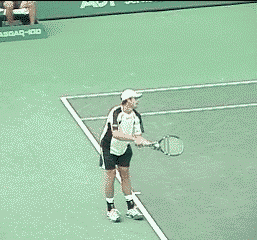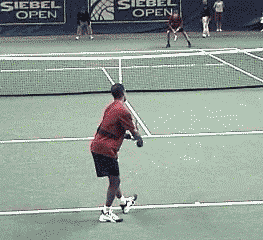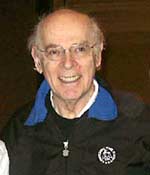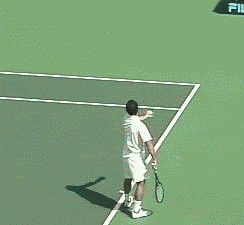|
TennisOne Lessons Hitting 150 mph (240 km/h) Serves Howard Brody, Physics Department, University of Pennslyvania
The world record for serve speed (149 mph or 240 km/h) was held by Greg Rusedski but Andy Roddick has upped that to 155 mph. Is there an upper limit set by physics and geometry on how fast the fastest possible serve can be? NO! For any player six foot (1.83 m) tall or taller, there is no limit on serve speed set by physics and the geometry of the tennis court. Bruce Elliott has shown that tennis players hit their serve at a height that is one and a half times their actual height. On this basis a six-foot tall player will strike the ball at a height of nine feet. Rusedski, who is six-foot, four inches tall, will hit the ball at a height of nine feet, six inches above the ground. If you take a straight line from the service line and just skim the top of the net, it will cross the plane of the baseline at a height of eight feet, nine inches. This means that any player hitting the ball at that height (or higher) does not need gravity to pull the ball down into the service box. Does that mean that it doesn't matter how tall you are as long as you are over six feet tall? NO! Does that mean it is as easy to get in a 155 mph serve as a 100 mph serve? NO! Let us examine the effect of gravity and geometry on the ability of a player to get the serve to go in.
First, let us look at the groundstroke. A typical groundstroke is hit from the baseline at a height of three feet and must clear a three foot high net. If there were no gravity, the ball would sail over the opposite baseline at a height of three feet (it would travel in a straight line). Air resistance will not make the ball's path deviate from a straight line. Turn on gravity and it will pull the ball into the court. The more time gravity has to work on the ball, the shorter the bounce will be. If the ball is hit hard, gravity has less time to affect the ball, and it will bounce deeper in the court or go long. The same argument holds for the serve. Even though a serve, for a tall player, can land in the service box without gravity, turning gravity on will make it easier to get the ball to bounce within the box. Hitting the ball hard reduces the time gravity has to act and makes it more difficult to get the serve to go in. The higher the ball is when hit, the more of the service box is available for the ball to land in, just from geometry. So hitting the serve from a higher impact point and not hitting it as hard will increase the chances of the serve being good.
You cannot do much about the height of your ball impact, except be fully extended when you strike the ball. However, no amount of practice will change your own physical dimensions. You also want to hit your serve hard to make it difficult for your opponent to return it, yet you want to get most of your serves to be good. What can you do to get more serves in? Add some topspin. Topspin opens the window by providing an additional downward force (the Magnus Force) on the ball. It is as if gravity were increased. To put topspin on a serve, the racquet usually must be moving upward as well as forward at the instant of impact. However, if the racquet is moving upward at impact, the server is not hitting the ball at full extension. The topspin will enlarge the window, while hitting below full extension will close the window a little, usually leaving a net increase in the acceptance window, which means more serves will go in. Getting topspin on the serve is not as easy to do on the court as it is to talk about it in this note, but there is a way around this problem. Many players hit their serve when the ball they toss up reaches its peak. If instead, the player were to toss the ball up about 8 inches (20 cm) above the eventual impact point and hit the ball as it was falling, topspin would automatically be added to the ball, with no additional effort by the server. It would not be a lot of topspin (about 10 revolutions/second), but enough to open up the window and allow more serves to go in.
If you are already hitting the ball at a height of 9 feet or more and not hitting it very hard (about 120 mph or 193 km/h), this extra spin will open the window by about 29% since the window is already large. If you try to hit the serve very hard (150 mph and you succeed) you will have a small acceptance window, but the 10 rps of topspin will help you to get an extra 41% of your serves in. Getting back to the 149 mph serve. How much better is it than a 120 mph serve, assuming that you can get it to go in? It takes a 120 mph serve 0.59 seconds to go from the racquet, through bounce and to the opposite baseline. It takes a 149 mph serve 0.47 seconds for the same trip. This is a difference of 0.12 seconds, or about1/8 of a second. Where you might have some chance of returning a 120 mph serve (if it is hit near you), take away 1/8 of a second from your 120 mph time and it is unlikely you will return it - unless you take a guess as to where it will be going - and guess correctly. Your comments are welcome. Let us know what you think about Howard Brody's article by emailing us here at TennisONE.
Professor Brody is a member the International Tennis Federation Technical Commission, the USTA Sports Science Committee, USTA Technical Committee, science advisor to the Professional Tennis Registry, technical advisor to the United States Racquet Stringers Association, on the Editorial Board of the Journal of Sports Engineering, and on the technical advisory panel of Tennis Magazine. His book Tennis Science for Tennis Players was published by the University of Pennsylvania Press in 1987. He and Vic Braden are featured in a video “The Science and Myths of Tennis.” As one of the principal authors who have written an NSF sponsored high school physics course (Active Physics), he was responsible for the chapters dealing with the physics of sports. He has received the USPTR Plagenhoef award for sports science in 1996 and the International Tennis Hall of Fame Educational Merit Award for the year 2000. His latest book, The Physics and Technology of Tennis, written with Rod Cross and Crawford Lindsey was published in late 2002. He is also one of the principal authors of the CD-ROM on The Science of Tennis funded by the Lawn Tennis Association Coach Education. At the 2003 Tennis Science and Technology Congress, the ITF gave a prize for the best paper presented and named it the “Howard Brody Award” for his service to tennis. |



 You may think of this in terms of a window at the net (it is called the acceptance window). You must get the ball to go through a certain window if the serve is to be good. The higher the ball impact location, the bigger is the window. The higher the ball speed, the smaller is the window.
You may think of this in terms of a window at the net (it is called the acceptance window). You must get the ball to go through a certain window if the serve is to be good. The higher the ball impact location, the bigger is the window. The higher the ball speed, the smaller is the window. 

 Dr. Howard Brody is an emeritus professor of physics at the University of Pennsylvania , where he was interim varsity tennis coach for part of the 1991 season. He played varsity tennis and earned his bachelor's degree at MIT and his master's and doctoral degrees at Cal Tech. Recently he has been investigating the physics of sports, particularly tennis. He has written many papers and articles on the subject, given numerous lectures and talks on tennis, and done several television programs explaining the science behind tennis, football, and baseball.
Dr. Howard Brody is an emeritus professor of physics at the University of Pennsylvania , where he was interim varsity tennis coach for part of the 1991 season. He played varsity tennis and earned his bachelor's degree at MIT and his master's and doctoral degrees at Cal Tech. Recently he has been investigating the physics of sports, particularly tennis. He has written many papers and articles on the subject, given numerous lectures and talks on tennis, and done several television programs explaining the science behind tennis, football, and baseball.